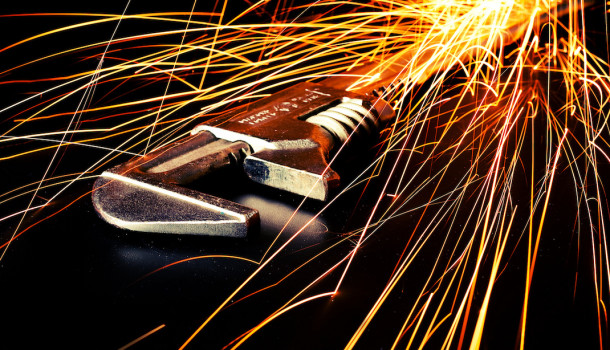
“Innovation isn’t just about coming up with the next cool product,” says Hoque, a serial entrepreneur, founder of SHADOKA, and author of the books Everything Connects and Survive to Thrive.
If innovation has no end point, and if it’s not about coming up with the latest “cool” product, why isn’t your electrical distributorship running like a well-oiled innovation machine?
As the valued go-betweens that work with product manufacturers on one side and customers on the other, industrial distributors are prone to “losing their places” on the innovation chain. In other words, as their suppliers develop new products and services, and as their customers use those raw materials to build out their own projects, electrical distributors aren’t always seen as innovation machines.
Faisal Hoque says distributors that buy into the theory that they aren’t born innovators are missing the boat. “Innovation isn’t just about coming up with the next cool product,” says Hoque, a serial entrepreneur, founder of SHADOKA, and author of the books Everything Connects – How to Transform and Lead in the Age of Creativity, Innovation and Sustainability and Survive to Thrive – 27 Practices of Resilient Entrepreneurs, Innovators, and Leaders.
“Innovation has no end point,” Hoque continues, “and it includes everything from how you take your product to market to how you serve your customer to how you come up with effective pricing solutions. All of these activities fall under the broader contexts of innovation and go well beyond the very narrow ‘cocktail napkin’ approach to innovation.”
“Innovation has no end point.”
By expanding the very definition of innovation to include pricing, customer service, and other day-to-day activities that distributors partake in, Hoque helps companies break out of their shells and realize that even the supposed “middleman” in a business transaction can be an innovation machine. By adopting this mindset, he says companies can not only become more competitive and customer-friendly, but they can also become more profitable. The latter is a particularly important point in the electrical distribution industry, where thinner and thinner margins are challenging distributors to find more innovative ways to generate revenues.
“Pretty much every business that’s surviving today – and that will survive for the long haul – will have to be competitive and innovative across all segments of their workflows,” says Hoque. “From hiring and compensation to selling to market strategy, positioning, and branding; all of these elements are part and parcel of innovation.”

If You’re Not Innovating, You’re Dead in the Water
As he surveys the industrial distribution landscape, Hoque says that basically all companies that are “surviving” are leveraging innovation in some way – whether they know it or not. “If they’re not innovating at this point, then they’re not going to be in business for long,” says Hoque. Of course, for some companies the urge to innovate comes naturally. A maker of highly-engineered products, for example, is always on the lookout for the next best product introduction and spends much time and money honing its existing offerings. Hoque says distributors have the same opportunities to innovate, and particularly when they are pushed to do so by forward-thinking personalities, leaders, and/or owners. “A lot of distributors and wholesalers are working in commodity-driven markets,” he points out, “so the competition is fierce.”
The companies that are succeeding in those competitive markets tend to follow some basic principles, says Hoque, regardless of the specific industry or role. The first principle is a tight focus on this question: What is our purpose? In other words, why are you here and what purpose does your company serve? “The purpose-driven organization has a much better chance of succeeding than the one that’s just ‘selling something to people,’” says Hoque, who points to Apple and Google as two examples of firms that are well known for their innovative and creative strategies – not all of which are focused on product development.
“Think beyond just creating a product to your intrinsic value proposition, be it to serve your customers better, save the planet, or some other core value,” says Hoque. “Through this exercise you’ll be able to create an identity and a true purpose that, in turn, [dictates] your firm’s position in its industry.” Having a value proposition in place also helps distributors answer questions like “How am I going to serve my customer?” “How am I going to price my products and services?” and “How can we create a better execution model for success?”
The Next, Innovative Steps
 With a solid value proposition in place, distributors must consider their core competencies. Then, turn those core competencies into a set of capabilities or differentiations that will be used to build out the firm’s platform (i.e., its product and service offering). “You may have a great vision and terrific partners,” Hoque points out, “but if you can’t create a service platform then you’re not going to be able to develop a [profitable] model.”
With a solid value proposition in place, distributors must consider their core competencies. Then, turn those core competencies into a set of capabilities or differentiations that will be used to build out the firm’s platform (i.e., its product and service offering). “You may have a great vision and terrific partners,” Hoque points out, “but if you can’t create a service platform then you’re not going to be able to develop a [profitable] model.”
Finally, Hoque says distributors should focus on creating what he calls a “nurturing ecosystem” that includes suppliers, customers, and other business partners. This is particularly important in the distribution segment, where companies rely on their suppliers to deliver quality products, their employees to sell, deliver, and support the equipment, and their customers to put the products to work out in the field. By continually nurturing that ecosystem, Hoque says electrical distributors can innovate effectively on a regular basis.
“This combination of purpose, platform, and ecosystem can be utilized across all innovation models,” says Hoque, “whether you’re talking about customer service, products, services, or any other platform. You can build it with those three guiding principles.”
Stoking Customer-Centric Innovation
Ultimately, Hoque says distributors should focus on those customer-centric values that are vital to innovation. For example, how can you give your customers a sense of enhancement by doing business with you? The answer to that question can often serve as the innovative distributor’s best friend in today’s competitive business environment.
“For distributors, actually pinpointing the innovation itself can be tricky. Because they’re usually selling someone else’s product, the service innovation that ‘wraps around’ the offering is a good starting point,” says Hoque. “By focusing on customer-centric innovation you can really make the differentiation and stand out in the marketplace.”
SIDEBAR
What Does Innovation Look Like in Action?
Faisal Hoque lays out the framework for innovation at the distributorship level
When he talks about innovation, SHADOKA’s Faisal Hoque knows he’s bound to get some questioning looks from leaders whose firms aren’t exactly in the position to churn out a string of new products every quarter. He also knows that as perpetual “middlemen,” distributors don’t always think of themselves as innovators, creators, or developers.
To help illustrate what innovation looks like at the distributorship level, Hoque points to a very fundamental product: water heaters. Acknowledging that these items don’t fall under the guise of the typical NAED member, Hoque says the fact that water heaters tend to be seen as commodities makes them applicable for a very fundamental and understandable example.
“I sell a water heater, and so what’s my differentiation? Anyone can go on Home Depot or Lowe’s and buy one,” Hoque explains. “You can find the answer to this question by asking yourself what core competency you bring to the table that adds value above and beyond just selling and delivering a product.” A few possible answers could be: I’m delighting the customer by delivering a high level of customer service, I know how to handle certain types of complicated installations, or I’m servicing these products 24/7 on both a residential and commercial level.
“It goes back to your service and delivery platform which, in turn, becomes your core competency,” says Hoque. In the case of the water heater distributor, for example, one purpose could be to serve a certain income group (i.e., homeowners who are in the middle-income bracket). To achieve that goal, the company would need a support structure or “ecosystem” comprised of its manufacturers (to make the products), workforce (to sell, deliver, and support the products), and customer base (homeowners, residential real estate agents, commercial brokers, and so forth).
In this example, Hoque says the innovation in question is the firm’s ability to “define that niche purpose or vision that makes the company a differentiator.” Ignore this important aspect of your business model, he warns, and no one will want to do business with you. “You’ll wind up being the same old, same old,” says Hoque. “You can avoid this problem by looking carefully at the value that you’re adding and exactly how you’re interacting within the community or ecosystem that you’re supporting.”
While the three principles of innovation that Hoque preaches are straightforward, he says getting business owners and leaders to sit down and discuss their firm’s purpose and how that translates into the organization’s overall vision can be challenging. “A lot of companies just can’t articulate those points and that’s a very big problem in the business world,” says Hoque. “The seller of water heaters, for example, will have to think pretty hard about what it’s good at and how that creates a differentiating service for its customers.”
Despite the challenges that innovation presents for the average firm, Hoque advises electrical distributors to keep plugging away in their quest to find differentiations, value-added services, and extreme customer service strategies. “With technological enablement, global access, and consumer behaviors all creating a much more competitive environment that anyone has ever seen,” says Hoque, “companies that choose not to innovate are going to be out of business – plain and simple.”
—
McCrea is a Florida-based writer who covers business, industrial, and educational topics for a variety of magazines and journals.
[Image: Flickr User Christian Steinmetz]
Original article @tEDMagazine.















